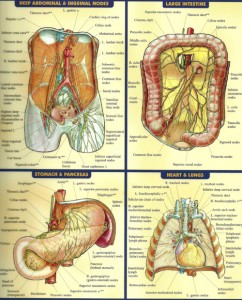The most underrated circulatory system in the human body is our Lymphatic System. Most health practitioners never consider the critical role lymph plays in preventing sickness or the critical role it plays in keeping us healthy!

The Lymph System is a vital circulatory system and the body’s primary immune defense and waste eliminator system; it is critical to managing the elimination of toxins from our body. It contains over 600 ‘collection’ sites called ‘lymph nodes’ and has a network of collecting vessels, making it even more extensive than the venous system. Our Lymphatic System is primarily responsible for carrying disease-fighting material to cells attacked by germs, transporting the dead germs away, and supplying protein-rich plasma fluid back to the heart. When this system is blocked, we become defenseless against attacks by viruses, fungi and bacterium.
Medical research explains the Lymphatic System as the primary system used by all immunological support elements (such as macrophages, T-Cells, B-Cells, lymphocytes, etc.) to fight the virus, fungus and bacteria attacking our body. It is also composed of over 50% plasma protein and is the major system carrying nutrition-rich plasma protein back into our blood. When the Lymph System is blocked, infection-fighting material is prevented from destroying germs and cell-nourishing elements are prevented from reaching our blood. As a result, germs grow, our blood loses needed protein, the immune system falters and infectious diseases march in.
With the Lymphatic System blocked, an engorged (swollen) condition may result in our

lymph nodes. In a recent AIDS study by Dr. Fauci, NIH Allergy & Infectious Disease Center, a blocked lymphatic system “results in providing a breeding ground (especially for the HIV virus) for pathogenic material. The Lymph System acts as a reservoir of infection churning out billions of HIV-infected immune-system cells that eventually spill into the blood stream, where they travel to other parts of the body. Much later, after enduring years of viral proliferation, the immune system begins to falter, and infectious disease marches in.” Studies reveal that “up to 10 times as much virus may reside in the Lymph System as in the blood.”
Most chronic disease problems occur at the junction of lymph vessels called ‘lymph nodes’. One can feel lymph nodes by pressing under the arms just below the collarbone or in the crease between the thigh and pelvic area. When touching these areas, many people will feel small bumps and sometimes pain. The bumps and pain are symptomatic of blocked lymph nodes. Blocked lymph nodes indicate a breakdown in the mechanical functioning of the lymphatic system. See common lymph tenderness areas shown by dark areas:
In men, the inguinal nodes, located in the area (crease) of the groin between the genitals and the thigh, are the primary channels for letting accumulated lymph (protein and fluid) release from the prostate. In women, the axillary nodes, located in the armpit and extending from the armpit down towards the breast, are the primary channel for releasing accumulated lymph (protein and fluid) from the breast. In many prostate, breast and other cancer situations, these lymph nodes may be heavily burdened and often become enlarged, resulting in reduced ability to eliminate lymphatic fluid.
The LBG
The issue of lymphatic flow has been studied for many years with in-depth clinical research resulting in very efficient manual methods for restoring the lymph system. Using manual lymph drainage techniques in conjunction with LBG non-invasive technology can help affect a swift, safe and natural method of eliminating excess lymphatic fluid. The LBG assists the body to achieve a free-flow of proteins within the lymph system and to release bonded protein blockages in the areas of connective tissue.
The LBG is non-invasive technology and uses extremely low current and negatively charged light photons to provide compatible frequencies to blocked area resulting in cells correcting their out-of-balance condition and disassociating themselves from the binding agents responsible for swelling and blockage. Rapid movement of waste material within the cell can then occur, greatly increasing the delivery of waste material to the organs responsible for body waste disposal. The efficiency of hands-on therapy is increased as free-flow of proteins speeds the healing process. As waste material is now more effectively moving within the body, day to day factors like eating habits, body structure, nutrition, medication and mental health can be addressed to provide a successful formula for restoring and then maintaining health.
Common conditions that may receive relief from the use of lymph massage and the LBG are: pain, especially as it involves soft tissue, sciatica, breast conditions, fibrocystic disease, PMS, intestinal syndromes, diabetes, arthritis, swelling, chronic edema, bursitis and other conditions involving inflammation, bruising, pre-surgery preparation and post-surgical recovery.
